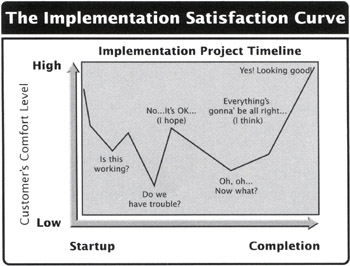
|


|
Delivering the Solution
What does the conventional salesperson do after the sale is closed? Move on to the next victim. That sounds harsh, but unfortunately, that is exactly how many customers believe salespeople behave. Aware salespeople deal with this prejudice by breaking type once again and remaining conspicuously involved in the delivery and implementation of solutions.
Our involvement in the delivery of the solution grows out of a simple idea: A single order does not make a relationship. Relationships are built on dependability and the customers' ability and willingness to rely on our expertise whenever they need assistance. When salespeople hand off customers and move on to new customers, no matter how smooth and problem-free the process, customers are going to perceive this as an abandonment of the relationship.
We are not saying that salespeople should spend all of their time with existing customers. Obviously, a major part of a salesperson's job is to discover, engage, and establish new accounts. But too often, salespeople move on too quickly. We need to recognize the value of existing customers and devote a significant portion of our time to the retention and expansion of our relationships with those customers. This value is well documented. A study by Bain & Company calculated that in the insurance industry, a 5 percent increase in retention results in a 60 percent jump in profits; in employer services, a 4 percent increase in retention results in a 21 percent jump in profits; and in banking, a 5 percent increase in retention results in a 40 percent increase in profits. [2] When salespeople stay directly involved with customers during and after the delivery of the solution, they capture a sizable opportunity.
The same cooperative and diagnostic skills that carried us through the previous phases of the sale process are put to work in the physical delivery of the solution. Trained salespeople start this work by confronting and communicating the implementation problems that their customers regularly encounter. If your company never has implementation problems, this doesn't apply. However, in our experience, that is rarely the case. We find that the typical solution implementation and a customer's reaction to it look something like Figure 7.1.
Typically, salespeople gloss over the ups and downs of implementation. Perhaps hoping that problems will not occur, they try to ignore them. Thus, when problems do pop up, customers are not anticipating them and are caught by surprise, maximizing their dissatisfaction. This, in turn, forces the salesperson and the service and support staff to spend too much time in damage control and recovery, or risk a worse reaction from the unhappy customer.
One way in which this negative cycle can be avoided is by analyzing the problems and negative reactions that tend to surface in delivery and defuse them before their occurrence. We have found that a new sales process elicited strong, defensive feelings from a small percentage of salespeople who felt extremely threatened by the idea of changing their business-as-usual mind-sets. The reaction of this group was to attack - they would corner their managers and complain that these new ideas were impossible to execute and it was sheer insanity to even consider adopting them. This caused managers to start questioning the effectiveness of a new sales program.
We have discovered that complaints almost exclusively come from the lowest ranks of salesforces. Surprisingly, those who needed the most help were resisting it the most. Managers should expect to hear a small number of participants attack these new concepts; these complainers will likely be among their least effective performers. If these managers are prepared beforehand with an effective script they will still hear a few complaints, but they handle them with ease. Thus, an implementation problem is defused before it occurs.
Defusing potential problems before they occur is an excellent, practical solution to delivery snafus, but we also recognize that salespeople won't be able to anticipate every implementation problem. Another way to break the negative cycle that begins when customers are unpleasantly surprised during implementation is to adopt a mind-set that admits the possibility of problems and prepares you to address them.
The fact that customers experience problems in the implementation of a solution is often less of an issue than how salespeople respond. Informed salespeople prepare for these problems by understanding that they do occur, providing the customer with the means to report those problems, and, most importantly, by reacting to reported problems in a cooperative manner by acting as a business partner and diagnostician.
[2]Donna Greiner and Theodore Kinni, 1,001 Ways to Keep Customers Coming Back (Rocklin, CA: Prima, 1999), p. 148.
The topics covered herein concern solution sales, consultative sales, and consultative selling.

|


|
